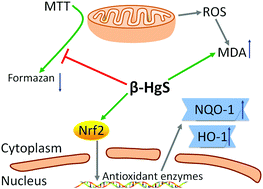Effects of β-HgS on cell viability and intracellular oxidative stress in PC-12 cells†
Abstract
Traditional Tibetan medicines containing β-HgS have been used to treat chronic ailments for thousands of years. However, there has recently been speculation regarding the safety of these medicines due to their high mercury content. Although the toxic effect of β-HgS has been previously investigated in vivo, the mechanism underlying the toxicity of this compound remains unclear. In this study, we investigate the mechanism of β-HgS cytotoxicity via experiments performed on rat adrenal gland tumor cells (PC-12). Specifically, we analyze the viability and intracellular oxidative stress state of PC-12 cells treated with varying concentrations of β-HgS. For comparison purposes, the effects of MeHgCl and HgCl2, two Hg-based compounds, on ROS generation and MDA, GSH/GSSG, Nrf2, NQO-1, and HO-1 levels are also determined. It should be noted that we used the small-molecule thiols of cell culture medium, such as cysteine, to increase the solubility of β-HgS and prepare a β-HgS solution to treat PC-12 cells. The obtained results show that β-HgS inhibits cell viability at concentrations of 200–1000 ng Hg mL−1 (48 h treatment). In the concentration range of 200–600 ng Hg mL−1 (24 h treatment), the inhibitory effect of β-HgS is stronger than that of MeHgCl; however, this trend is reversed at higher concentrations (800–1000 ng mL−1) and longer exposure times (48 h). Moreover, β-HgS significantly promotes MDA, but has no appreciable influence on cell apoptosis and ROS generation in PC-12 cells, which suggests that its inhibitory effect on cell viability might be related to the stimulation of ROS-independent oxidative stress. Notably, β-HgS and HgCl2 significantly increase the GSH content, GSH/GSSG ratio, NQO-1 mRNA expression, and HO-1 protein expression in PC-12 cells, indicating that the antioxidant protection against these compounds is triggered by Nrf2 activation. HPLC-AFS analysis shows that in β-HgS and HgCl2 solutions, mercury exists in the same form of Hg2+, but the cytotoxicity of the former is greater. This is probably due to the additional oxidative damage induced by the S2− ion in β-HgS. In conclusion, β-HgS induces ROS-independent oxidative stress in PC-12 cells, and thus, is obviously cytotoxic. At the same time, it promotes the antioxidant capacity of cells by activating the Nrf2 pathway.



 Please wait while we load your content...
Please wait while we load your content...